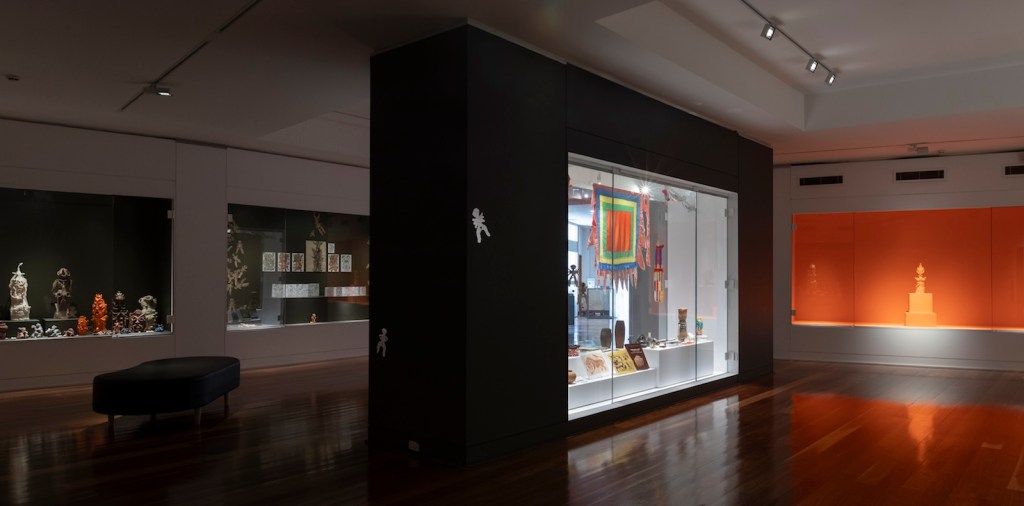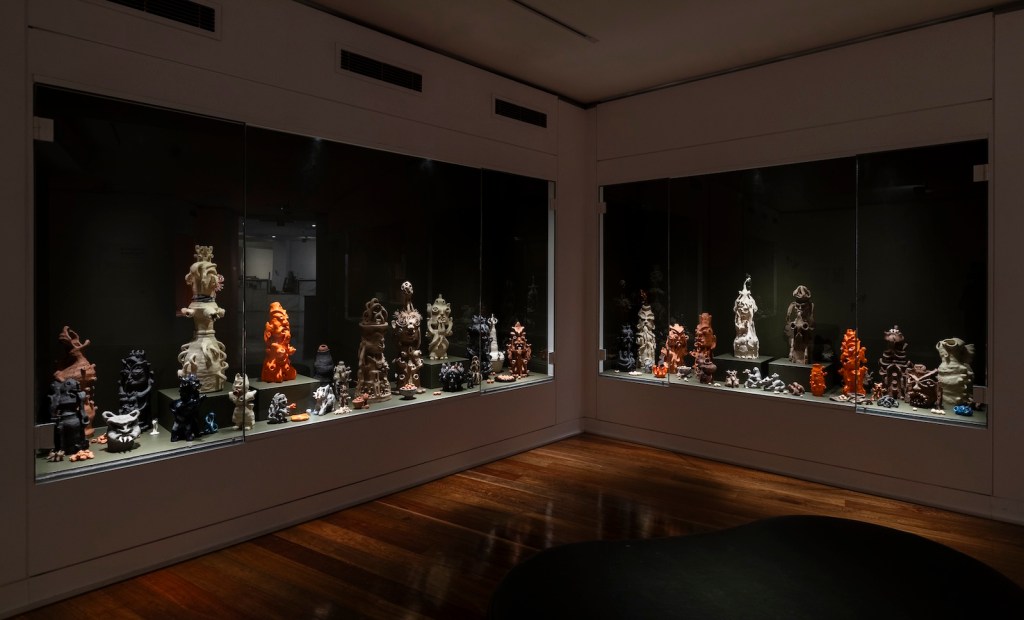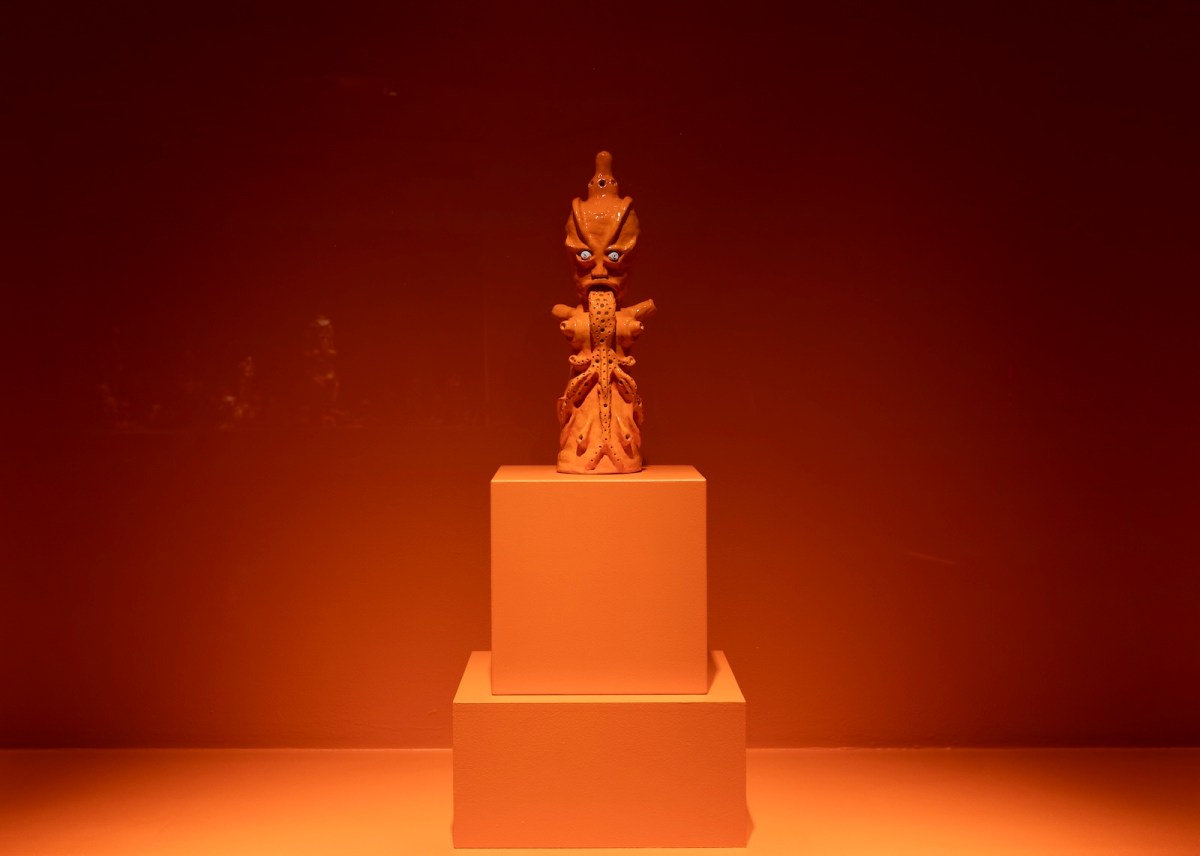The Mann-Tatlow exhibition space, within the Wollongong Art Gallery, was created to house the Mann-Tatlow Collection of Asian Art, a collection amassed over a 25-year period by William S Tatlow and Gora Singh Mann, and gifted to the Gallery in 2003.
Its objects – stretching from the Neolithic period to the early 20th century, and including many ceramics – sit in glass-fronted vitrines, instilling notions of “revered” and “authority” in viewers. Of the 227 Asian objects in the collection, however, Vietnamese artefacts and ceramics are overlooked.
It is not surprising, then, that the space provided a fitting takeover for Mai Nguyễn-Long, whose new body of sculptural ceramics questions the arbiters of history and value, and cultural invisibility or erasure.
The exhibition opened in the closing months of 2023, and coincided with the 50th anniversary of diplomatic relations between Australia and Vietnam. It also followed the publication of the artist’s mother’s book, Vietnam Visual Arts in History Religion & Culture (2023). Kerry Nguyễn-Long is a respected voice on Vietnamese ceramics, in particular, and it has only been in recent years that Mai Nguyễn-Long has allowed herself to celebrate those cultural connections, with her own voice.
That very individual voice has been getting louder, reaching a pivot point with her inclusion in the Berlin Biennale (2022), when her alter ego/moniker, Vomit Girl, became Kotzmädchen or “puke girl”. Kôgábịnô is simply the next iteration of Vomit Girl. This kind of slide, or slight mistranslation, is the kernel to this exhibition. Nguyễn-Long has long been interested in the diasporic experience, in particular feelings of displacement and resistance.
What is particularly intriguing with this exhibition is that, in a first, Nguyễn-Long pairs her sculptures with collected personal artefacts. Among other things, they include empty bullet shells gleaned from a refugee camp on the Vietnamese/Cambodian border, Nguyễn-Long’s self-harm kit, a warplane metal ruler made by her uncle in a re-education camp and đình festival flags faded by the harsh Australian sun. They sit alongside her sketch books, which concertina with the rhythm of daily repetition and ritual. They’re shown in a vitrine that sits central to the exhibition, and acts as a kind of personal “validator”.

There is a lot to take in with this exhibition; it’s deeply layered with reams of research, memory and trauma, and yet reads as a resolved sense of elevation above those eddies. The sculptures themselves have a heavy, earthy quality – emphasised through their hand-built technique and often left unglazed.
She also speaks of her building technique as conceptually referencing doba, the cylindrical form of disused artillery shells, often repurposed as village bells. It is such a rich symbol for the very essence of agitation, and repair, which is consistently central to her practice.
The exhibition has been beautifully lit, allowing the subtle muted colours and matte finishes to come alive. The parade of “characters” is punctuated by some sculptures glazed with a punchy orange colour, which both breaks up the earthy tones and points to the chemical Agent Orange, which brought its own form of erasure in Vietnamese history.

A highlight of the exhibition is a vitrine painted this same orange, and displaying a single sculpture on a double dais-like pedestal. The object Vigit (Vomit Girl), where Vigit means: Goddess of Infected Tongues for all those who have lost their mother tongue, stares out to the viewer with piercing eyes, appearing grotesque or demonic with its long tongue, but rendered speechless.
Read: Exhibition review: Salote Tawale, Carriageworks
Long describes her practice as ‘an aesthetic of resistance’ that both has elements of play and takes a deep cultural dive. I have followed Nguyễn-Long’s work for many years now (I even curated her first survey show) and there is a marked shift in the tone with this exhibition. While her motifs constantly return, with Kôgábịnô there is a new confidence – greater celebration and a grounded quality that is sure in where it comes from, understanding its place now, and pushing itself forward.
Mai Nguyễn-Long: Kôgábịnô
Wollongong Art Gallery
Curated by Adam Porter
Until 7 April 2024
Free





